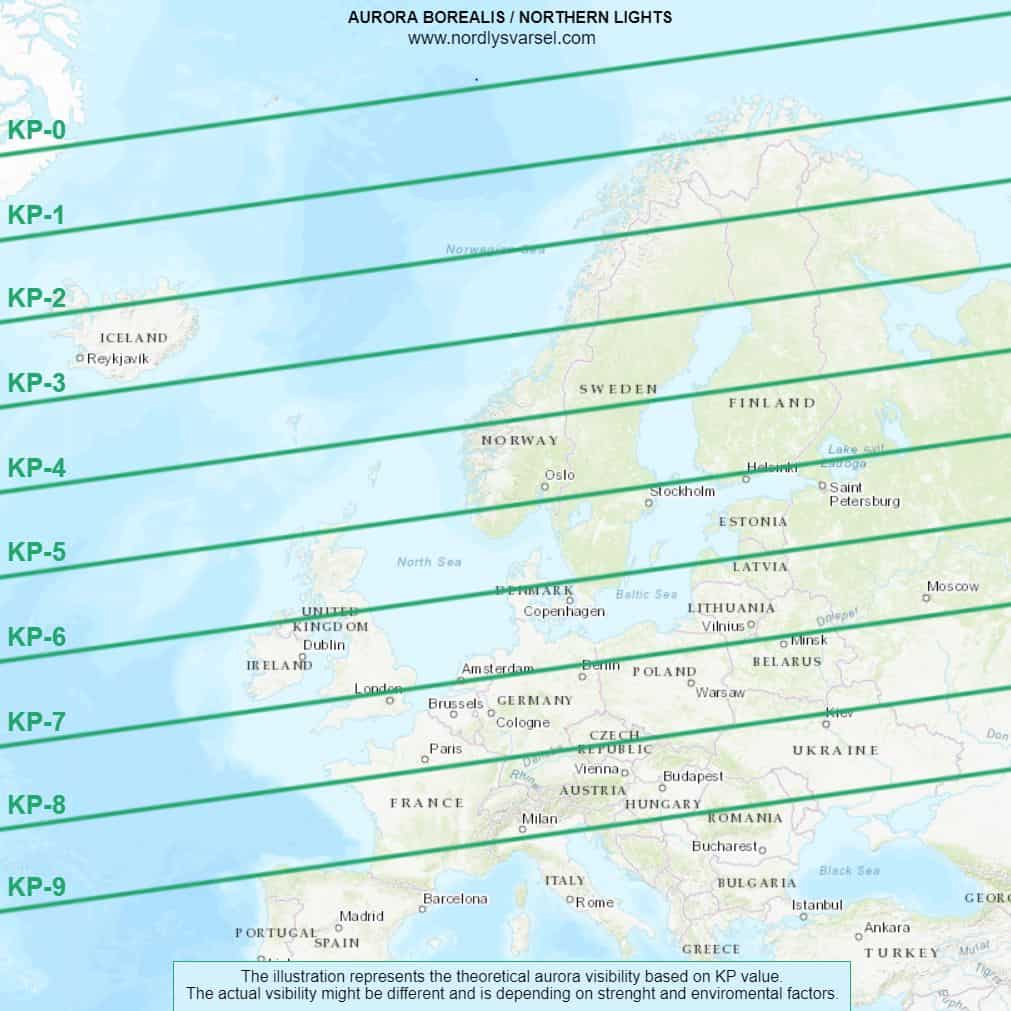How to read the northern lights forecast?
The northern lights are a fantastic natural phenomenon that occurs when particles from the sun interact with the Earth’s atmosphere. It can be an unforgettable experience to witness the dancing lights in the sky, which is why many people want to read the northern lights forecast to plan trips and activities accordingly. In this guide, I will provide you with some tips and tools to understand the northern lights forecast in a simple and comprehensible way. By understanding what influences aurora activity and how to read the northern lights forecast, you will have better chances of experiencing this magical phenomenon.
You can find a brief summary on the front page below the northern lights forecast and at the bottom of this article.
What is the KP index?
The KP index (Kp-index) is a measurement of magnetic activity in Earth’s magnetosphere, which is influenced by solar wind. The Kp index measures changes in Earth’s magnetic field, and its value can range from 0 to 9, where 0 signifies very little magnetic activity, and 9 indicates a very powerful magnetic storm.
The Kp index is calculated from data collected by multiple magnetometers worldwide. It is a standardized measurement used by meteorologists and space researchers to monitor aurora activity and magnetic storms. It is also useful for predicting future aurora activity.
In general, a Kp value of 5 or higher is considered moderate to high aurora activity and can provide a good chance of observing the northern lights from areas with low light pollution and clear sky conditions.
When determining the required Kp index for the northern lights to be visible where you are, you first need to know your latitude. You can search for municipalities here to quickly find the corresponding KP value. If you can’t find your municipality in the list, you can search for another municipality in your area or find your latitude on Latlong.net. Once you know your latitude, you can refer to the chart below to determine the necessary KP index for the northern lights to be visible at those latitudes.
Latitude 66.5 and higher = KP 0
Latitude 64.5 and higher = KP 1
Latitude 62.3 and higher = KP 2
Latitude 60.4 and higher = KP 3
Latitude 58.3 and higher = KP 4
Latitude 56.3 and higher = KP 5
Latitude 54.2 and higher = KP 6
Latitude 52.2 and higher = KP 7
Latitude 50.1 and higher = KP 8
Latitude 48.1 and higher = KP 9
It’s important to note that the KP index alone is not the sole factor determining whether the northern lights will be visible, as weather conditions and geographical latitude also play a role. Keep reading for even more tips on how to read the northern lights forecast.
What is Bz?
Bz stands for the interplanetary magnetic field component in the z-direction, and it plays a significant role in influencing Earth’s magnetosphere and, consequently, the northern lights.
Bz provides an indication of the direction in which solar particles enter Earth’s atmosphere, with a negative Bz value indicating that most particles will impact the Earth in northern latitudes, while a positive Bz value suggests that the particles will impact the Earth in southern latitudes.
However, a Bz value of 0 does not necessarily mean an even distribution of particles between north and south. A Bz value of 0 indicates that the solar wind’s magnetic field is parallel to Earth’s magnetic field, and this can allow the solar wind to penetrate Earth’s magnetosphere, leading to auroral activity in both northern and southern latitudes, depending on other factors such as the strength of the solar wind and Earth’s magnetic field.
What is solar wind?
Solar wind shows the speed of the particles coming from the sun, and this speed is measured in kilometers per second (km/s). A high speed of the solar wind can cause more particles to reach Earth’s atmosphere, increasing the chances of a strong and dancing northern lights display. This is because when the solar wind has a high speed, it can penetrate Earth’s magnetosphere and carry particles deeper into the atmosphere, which can, in turn, lead to more intense auroral activity.
A high speed of the solar wind can also result in the northern lights displaying colors other than just green. This is because high-speed particles interact with molecules and atoms in Earth’s atmosphere differently than at lower speeds, which can cause them to release more energy and produce different colors.
The normal speed of the solar wind is typically around 300 km/s, but it can vary significantly depending on solar activity. High-speed solar wind can usually range between 500 and 800 km/s, but solar wind is also known to reach even higher speeds during intense solar eruptions.
What is proton density?
Proton density indicates the amount of particles coming from the sun, and this value is usually given in cubic centimeters (cm³). Values below 10 cm³ are considered low, 20 cm³ are moderate, 40 cm³ are high, and over 60 cm³ are extremely high. High proton density can lead to stronger auroral activity because more particles will collide with the atmosphere and create light. On the other hand, low proton density can result in the aurora appearing weaker or not visible to the naked eye at all.
Summary
The KP index gives us an indication of how widely the auroral oval stretches and how far south the northern lights can be observed. The higher the KP value, the greater the chances of seeing the northern lights.
The Bz value measures the direction of the solar wind’s magnetic field when it reaches Earth, and a negative Bz value can lead to stronger auroral activity. High solar wind speed and high proton density can also increase the chances of seeing the northern lights.
The combination of these factors can provide a better indication of the type of auroral activity to expect. A high KP value, negative Bz value, high solar wind speed, and proton density can result in strong and dancing northern lights, while low values on these factors can lead to less visible or weak northern lights.
We hope this has made you more knowledgeable about how to read the northern lights forecast. Enjoy 🙂




